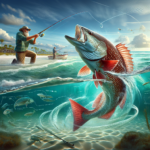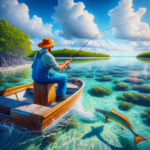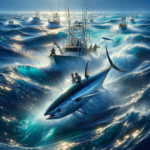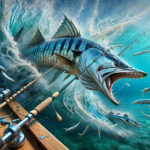Muskie Fishing in Wisconsin’s Inland Lakes
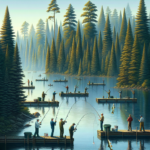
Introduction
Did you know that Wisconsin is home to some of the best muskie fishing in the United States? With over 15,000 inland lakes, the state offers a plethora of opportunities for anglers to catch this elusive and highly prized fish. This article will delve into the intricacies of muskie fishing in Wisconsin’s inland lakes, covering everything from the best fishing techniques and gear to the top fishing spots and seasonal considerations.
Whether you’re a seasoned angler or a novice looking to catch your first muskie, understanding the nuances of muskie fishing in Wisconsin can significantly enhance your experience. This guide aims to provide you with all the information you need to make your next fishing trip a success.
Background/Context
Historical or Cultural Significance
Muskie fishing has a rich history in Wisconsin, dating back to the early 20th century. The muskellunge, or muskie, is often referred to as the “fish of 10,000 casts” due to its elusive nature. This has made it a highly sought-after trophy fish among anglers. Wisconsin’s commitment to conservation and sustainable fishing practices has helped maintain healthy muskie populations, making the state a premier destination for muskie fishing.
Geographical Overview
Wisconsin’s diverse landscape includes over 15,000 inland lakes, many of which are prime habitats for muskies. The state’s climate, characterized by cold winters and warm summers, creates ideal conditions for muskie growth and activity. The local ecosystem, including abundant prey species like perch and walleye, supports a thriving muskie population.
Key Points/Details
Fishing Techniques
Technique Overview
Muskie fishing techniques can vary, but some of the most effective methods include casting, trolling, and fly fishing. Each technique has its own set of advantages and is suited to different conditions and locations.
When and Where to Use
Casting is often most effective in shallow waters during the early morning or late evening when muskies are more active. Trolling is ideal for covering larger areas and is particularly effective in deeper waters. Fly fishing, while more challenging, can be highly rewarding and is best suited for clear, shallow waters.
Recommended Gear
- Rods: Heavy-action rods are recommended for muskie fishing due to the fish’s size and strength.
- Reels: High-capacity baitcasting reels with strong drag systems are ideal.
- Lines: Braided lines with a test strength of at least 80 pounds are recommended.
- Bait/Lures: Large crankbaits, jerkbaits, and bucktail spinners are popular choices.
Species Information
Species Overview
The muskellunge, or muskie, is a large predatory fish known for its elongated body and sharp teeth. Muskies prefer clear, vegetated waters and are often found near structures like submerged logs and weed beds. They are most active during the warmer months and tend to feed aggressively in the early morning and late evening.
Best Practices
To successfully catch a muskie, it’s essential to use the right techniques and gear. Casting near structures and using large, flashy lures can attract muskies. Patience is key, as muskies are known for their elusive nature. It’s also important to practice catch and release to help maintain healthy muskie populations.
Location Information
Top Fishing Spots
- Lake of the Woods: Known for its large muskie population and excellent fishing conditions.
- Chippewa Flowage: Offers a variety of fishing environments, from shallow bays to deep channels.
- Lake Winnebago: One of the largest inland lakes in Wisconsin, providing ample opportunities for muskie fishing.
Regulations and Licenses
Wisconsin requires anglers to have a valid fishing license, which can be purchased online or at local retailers. There are also specific regulations regarding muskie fishing, including size limits and catch-and-release guidelines. It’s essential to familiarize yourself with these regulations to ensure a legal and sustainable fishing experience.
Seasonal Considerations
Seasonal Variations
Muskie fishing conditions can vary significantly throughout the year. In the spring, muskies are often found in shallow waters as they prepare to spawn. Summer months see muskies moving to deeper, cooler waters. Fall is considered one of the best times for muskie fishing, as the fish become more active in preparation for winter.
Best Times to Fish
The optimal times for muskie fishing are early morning and late evening, particularly during the warmer months. Fall is also an excellent season for muskie fishing, as the fish are more active and easier to locate.
Events and Tournaments
Event Overview
Wisconsin hosts several muskie fishing tournaments throughout the year, attracting anglers from across the country. Notable events include the National Championship Muskie Open and the Muskie Classic, both of which offer significant prizes and the opportunity to compete with top anglers.
Preparation Tips
To prepare for a muskie fishing tournament, it’s essential to practice your techniques and familiarize yourself with the tournament rules. Ensure your gear is in top condition and consider scouting the fishing location in advance to identify potential hotspots.
Tips and Best Practices
General Tips
- Always use a leader to prevent muskies from biting through your line.
- Practice patience and persistence, as muskie fishing can be challenging.
- Pay attention to weather conditions, as muskies are more active during overcast days.
Avoid Common Mistakes
- Avoid using light tackle, as muskies are strong and can easily break weak lines.
- Don’t overlook the importance of proper lure presentation; muskies are visual predators.
- Ensure you’re familiar with local fishing regulations to avoid fines and penalties.
Advanced Techniques
- Consider using live bait, such as suckers, for a more natural presentation.
- Experiment with different retrieval speeds and patterns to trigger strikes.
- Use electronics to locate underwater structures and identify potential muskie hotspots.
Gear and Equipment Recommendations
Essential Gear
- Heavy-action rod
- Baitcasting reel with strong drag system
- Braided line (80-pound test)
- Large crankbaits, jerkbaits, and bucktail spinners
Optional Gear/Upgrades
- Electronics for locating fish and underwater structures
- Live bait rigs
- High-quality polarized sunglasses for better visibility
Where to Buy or Rent
Local bait and tackle shops in Wisconsin offer a wide range of fishing gear. Online retailers like Bass Pro Shops and Cabela’s also provide extensive selections. For those looking to rent equipment, many local shops offer rental services, particularly in popular fishing areas.
Safety and Conservation
Safety Tips
- Always wear a life jacket when fishing from a boat.
- Be aware of weather conditions and avoid fishing during storms.
- Use caution when handling muskies, as their sharp teeth can cause injury.
Conservation Practices
- Practice catch and release to help maintain healthy muskie populations.
- Respect local wildlife and avoid disturbing natural habitats.
- Follow all fishing regulations and guidelines to ensure sustainable fishing practices.
Planning Your Trip
Accommodations
Wisconsin offers a variety of accommodations near popular fishing spots, including hotels, cabins, and campgrounds. Many fishing lodges provide amenities specifically tailored to anglers, such as boat rentals and guided fishing tours.
Travel Tips
When planning your trip, consider the best routes to your chosen fishing location. Many popular fishing spots are accessible by car, and some may require a short hike or boat ride. Ensure you have all necessary permits and licenses before heading out.
Additional Activities
Wisconsin offers a range of activities for non-fishing time, including hiking, boating, and wildlife watching. Many fishing areas are located near state parks and recreational areas, providing ample opportunities for outdoor exploration.
Frequently Asked Questions (FAQs)
What is the best time of year for muskie fishing in Wisconsin?
Fall is considered the best time for muskie fishing, as the fish are more active in preparation for winter. Early morning and late evening are also optimal times during the warmer months.
Do I need a special license to fish for muskies in Wisconsin?
Yes, you need a valid Wisconsin fishing license. There are also specific regulations regarding muskie fishing, including size limits and catch-and-release guidelines.
What gear do I need for muskie fishing?
Essential gear includes a heavy-action rod, a baitcasting reel with a strong drag system, braided line (80-pound test), and large lures such as crankbaits, jerkbaits, and bucktail spinners.
Conclusion
Muskie fishing in Wisconsin’s inland lakes offers a thrilling and rewarding experience for anglers of all skill levels. By understanding the best techniques, gear, and locations, you can significantly enhance your chances of catching this elusive fish. Remember to practice sustainable fishing practices and respect local regulations to help preserve Wisconsin’s rich fishing heritage for future generations.
So, gear up, head out to one of Wisconsin’s beautiful inland lakes, and experience the excitement of muskie fishing for yourself!

